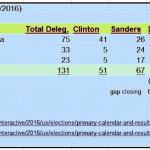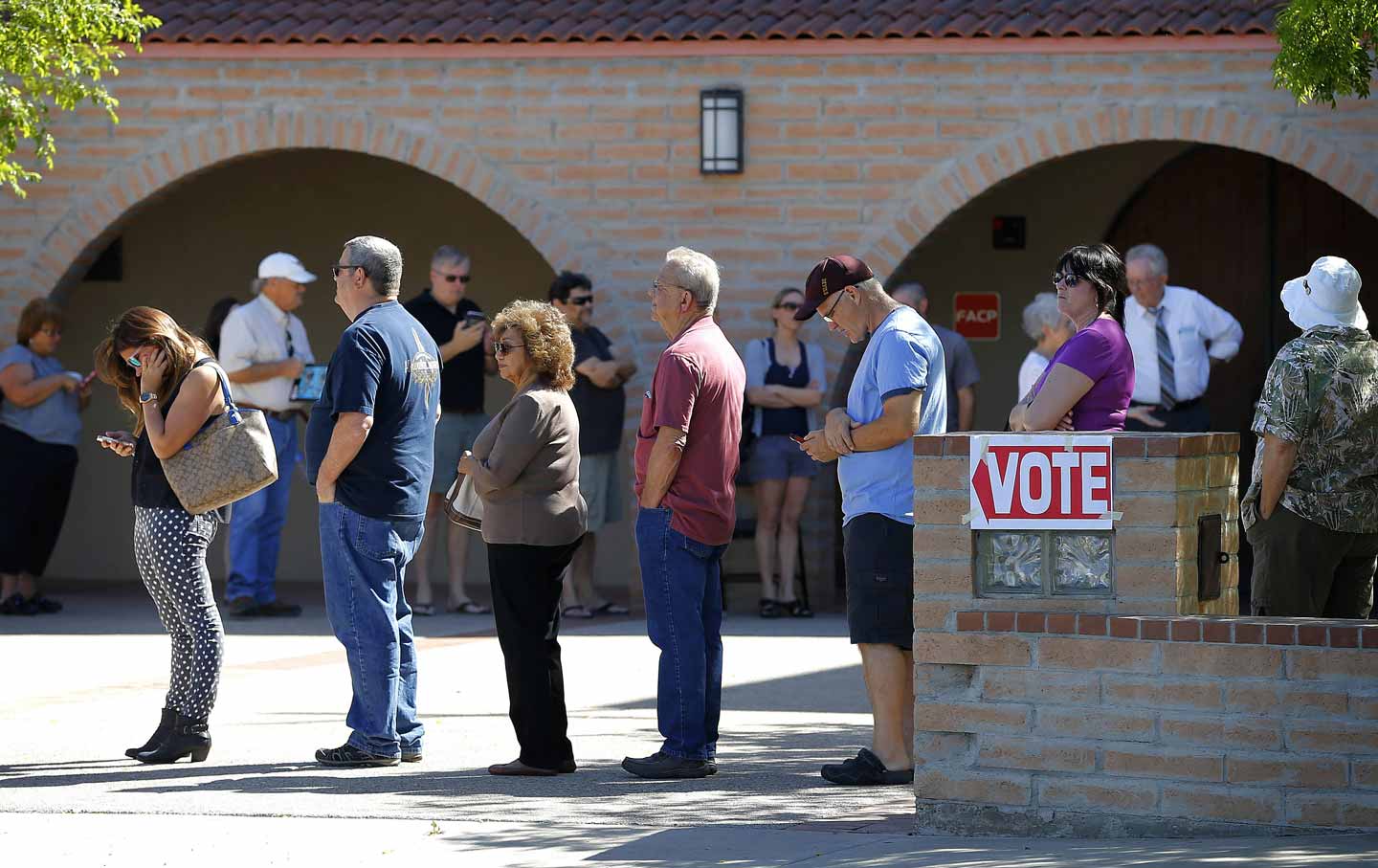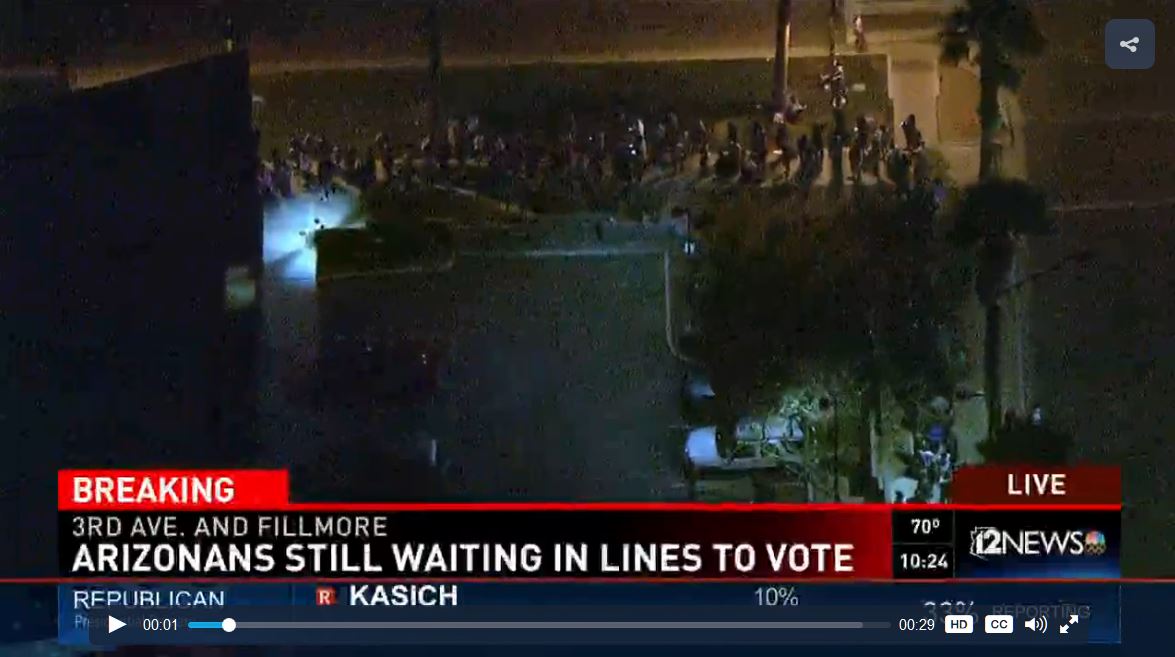The West Weighs In; Arizona Voting Suppression Scandal
https://portside.org/2016-03-24/west-weighs-arizona-voting-suppression-scandal

Portside Date:
Author: Robert Borosage; Ari Berman
Date of source:

- The Presidential Race: The West Weighs In - Robert Borosage (Campaign for America's Future)
- There Were 5-Hour Lines to Vote in Arizona Because the Supreme Court Gutted the Voting Rights Act - Ari Berman (The Nation)
- Phoenix Mayor Stanton Calls for Dept. of Justice Investigation of Voting Disaster - KPNX - NBC News 12
By Robert Borosage
March 23, 2016
Bernie Sanders is ignored by the media, dismissed by the pundits and the president, but he keeps on rising. Donald Trump continues to outrage, generating well-deserved condemnation in the media, opposition of panicked Republican poobahs and a barrage of negative ads from deep pocket superPACs, but he keeps extending his lead. This campaign is a long way from over.
On a day haunted by the terror in Brussels, voters flooded to the polls and caucuses in Arizona, Idaho and Utah. Hillary Clinton won Arizona handily, buoyed again by her continued edge among seniors and people of color. But Sanders gained in the delegate count by swamping her in the Idaho and Utah caucuses, generating recorded turnouts that overwhelmed caucus sites. The press will discount his victories as expected and his delegate gains as insufficient, but what's clear is that Sanders continues to generate growing excitement and support on the trail. The press says his only hope is to win by large margins in the remaining states. Well, in Idaho and Utah, he did just that.
The Sanders campaign raised more money than Clinton in February. Again the great bulk of his came from small donors - he has now more than 2 million of them. Clinton's fundraising continued to depend primarily on big donors who are maxing out. Sanders' passionate supporters are clearly ready to fuel his challenge through the convention.
Sanders continues to draw the biggest crowds of the election, Donald Trump's claims not withstanding. And Sanders continues to rise in the polls. The most recent CNN/ORC poll in mid-March showed Sanders closing to 51-44 percent among registered Democrats and Democratic leaning independents, substantially better than that poll's late February measure (55-38 percent Clinton).
Americans continue to express rising doubts about Clinton. In the most recent New York Times/CBS News poll, a disturbing 52 percent of voters hold negative views towards her (only 38 percent favorable). Those are unprecedented negatives exceeded only by those of Donald Trump (58 percent unfavorable). Trump and Clinton have the highest unfavorables since CBS began asking the question in 1984. This isn't just sexism. In March of 2008, against Barack Obama, her rating was a far better 39 favorable-41 unfavorable.
Sanders continues to run better than Clinton against any of the remaining Republican contenders. These results are understandably discounted, but they would be trumpeted if they showed Clinton faring better. One of Clinton's strongest assets in the race has been the belief that she was far more electable. These numbers begin to call that into question.
On Republican side, so-called "establishment" leaders from Romney to Rubio to Jeb! have swallowed hard and called for supporting Ted Cruz to stop Trump. Big money donors are spending millions attacking Trump. But the billionaire keeps on moving. Tuesday night, he won Arizona easily. He lost big in Utah to Cruz, but captured 60 percent of the delegates available on the night. The anti-Trump movement keeps building energy, but without making clear progress among Republican voters. In polls, Trump now garners the support of 47 percent of Republicans, showing little loss of momentum. The only relatively sane Republican contender, John Kasich, once more gained zero delegates on the night, enjoying only the pleasure of relegating Trump to third place in Utah.
The Democratic race, contrary to the punditry, will be competitive to the end. Sanders continues to generate extraordinary support among young voters. Clinton sustains her margins among the elderly and among people of color. Sanders must gain among the latter if he is to win the nomination.
Bill Clinton may help. While Hillary Clinton has presented herself as Barack Obama's proud successor to consolidate support among African-Americans, Bill Clinton has clearly been smarting as she's been forced to repudiate significant parts of his checkered legacy (financial deregulation, mass incarceration, corporate trade deals, although not, strikingly, welfare repeal). So this week, scorning those who would "litigate the past," he touted his wife as a change agent, the one most prepared to overcome "the awful legacy of the last eight years." Whoops. Bill and Hillary are no doubt eager to compare his record with Obama's to resuscitate his reputation and to show that "we know how to get things done with Republicans." But not yet. The campaign rushed to "correct" the Clinton remarks, suggesting that he was referring to Republican obstruction, not Obama's leadership.
The Republican horror show will continue. Establishment Republicans have somehow convinced themselves that rallying around a wingnut zealot, Ted Cruz, who yesterday called on the government "to patrol and secure" Muslim neighborhoods, is preferable to allowing a bloviating bully, Donald Trump, to rouse their own base against them. Thus far they've had little success, for Trump is simply offering a bare-knuckled version of their own dog-whistle politics. Like Caliban, he sneers: "You taught me language; and my profit on it is, I know how to curse."
Sanders' rise in the Democratic race continues. He has come a remarkably long way, exceeding all expectations. He has long odds against him, but much of the country still hasn't voted, and he's still gaining as he goes.
[Robert L. Borosage is the founder and president of the Institute for America's Future and co-director of its sister organization, the Campaign for America's Future. The organizations were launched by 100 prominent Americans to develop the policies, message and issue campaigns to help forge an enduring majority for progressive change in America. Mr. Borosage writes widely on political, economic and national security issues. He is a Contributing Editor at The Nation magazine, and a regular blogger at The Huffington Post. His articles have appeared in The American Prospect, The Washington Post, Tthe New York Times and the Philadelphia Inquirer. He edits the Campaign's Making Sense issues guides, and is co-editor of Taking Back America (with Katrina Vanden Heuvel) and The Next Agenda (with Roger Hickey).]
Reducing the number of polling places in Phoenix had catastrophic consequences in the March 22 primary.
By Ari Berman
March 23, 2016

Voters wait in line to cast their ballot in Arizona's presidential primary election on Tuesday, March 22, 2016 in Gilbert.
credit: AP Photo / Matt York // The Nation
Aracely Calderon, a naturalized citizen from Guatemala, arrived just before the polls closed at 7 pm in downtown Phoenix to vote in Arizona's primary last night. "When Calderon arrived, the line spanned more than 700 people and almost 4 blocks," the Arizona Republic reported. She waited in line for five hours, becoming the last voter in the state to cast a ballot at 12:12 am. "I'm here to exercise my right to vote," she said shortly before midnight, explaining why she stayed in line.
But many other Arizonans left the polls in disgust. The lines were so long because election officials in Phoenix's Maricopa County, the largest in the state, reduced the number of polling places by 70 percent from 2012 to 2016, from 200 to just 60 - one polling place per every 21,000 voters.
Election officials said they reduced the number of polling sites to save money - an ill-conceived decision that severely inconvenienced hundreds of thousands of voters. Previously, Maricopa County would have needed to receive federal approval for reducing the number of polling sites, because Arizona was one of 16 states where jurisdictions with a long history of discrimination had to submit their voting changes under Section 5 of the Voting Rights Act. This type of change would very likely have been blocked since minorities make up 40 percent of Maricopa County's population and reducing the number of polling places would have left minority voters worse off. Section 5 blocked 22 voting changes from taking effect in Arizona since the state was covered under the VRA in 1975 for discriminating against Hispanic and Native American voters.
But after the Supreme Court gutted the VRA in 2013, Arizona could make election changes without federal oversight. The long lines in Maricopa County last night were the latest example of the disastrous consequences of that decision.
"We are outraged at long lines for Arizona primary," The Arizona Republic wrote in a sharply worded editorial. The paper told stories of voters who left without casting a ballot because of the long lines.
Here's what one Maricopa County voter wrote to us:
"I literally went to multiple polling places, a total of FIVE separate times, only to find that the 1 hour wait (which I didn't have time for this morning) only increased as the day went on. Eventually, I gave up at 6:40 p.m. when I saw the line at its longest, at least 2-3 hours. This was the first time in my life I genuinely felt disenfranchised."
"Disenfranchised" was a flash word on Tuesday. Many voters used it.
This impacted voters across the county, but some more than others. There were predominantly Latino areas in Maricopa County with no polling places. "It is no coincidence many poor and predominantly Latino areas didn't get a polling place," wrote Arizona Republic columnist Elvia Diaz.
The 2016 election is the first in 50 years without the full protections of the VRA. Widespread voting problems during the primaries in states like Arizona and North Carolina are a disturbing preview of what could happen in November.
[Ari Berman is a senior contributing writer for The Nation.]
Copyright c 2016 The Nation. Reprinted with permission. May not be reprinted without permission. Distributed by Agence Global.
Please support our journalism. Get a digital subscription to The Nation for just $9.50!
March 23, 2016
Longer lines at fewer voting places lead to extremely long waits during the Arizona primary
Phoenix mayor Greg Stanton wrote an open letter to United States attorney general Loretta Lynch requesting an investigation into Tuesday's issues for Arizona voters in the presidential preference election.
"This is unacceptable anywhere in the United States, and I am angry that County elections officials allowed it to happen in my city," he wrote.
Critics have largely placed blame on Maricopa County recorder Helen Purcell.
READ: Mayor Greg Stanton's full letter to U.S. Attorney General Loretta Lynch
Stanton's strongly worded letter highlighted the decrease in the number of polling locations, noting that the 60 locations available to voters Tuesday were 70 and 85 percent fewer than those available in 2012 and 2008, respectively.
It also said that the county "distributed fewer polling locations to parts of the county with higher minority populations."
Stanton's letter said that his request "comes on the heels of consistent activity that has created a culture of voter disenfranchisement in this state," citing various numbers showing how many Arizona ballots have been discarded in recent elections.
Stanton is not the first public official to express his frustration with the way Tuesday's voting went -- Arizona governor Doug Ducey called the situation "unacceptable."

